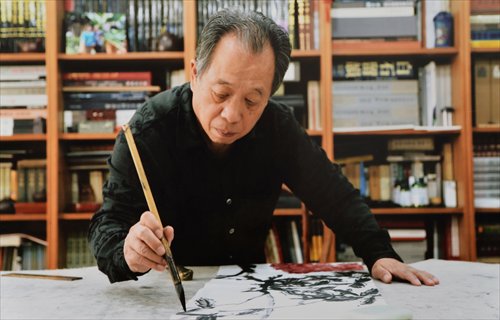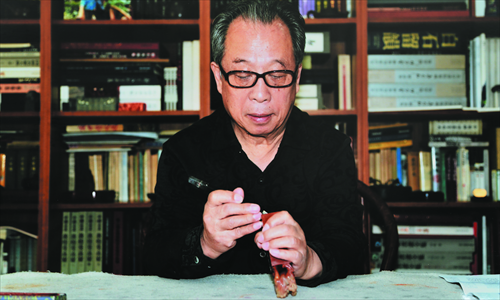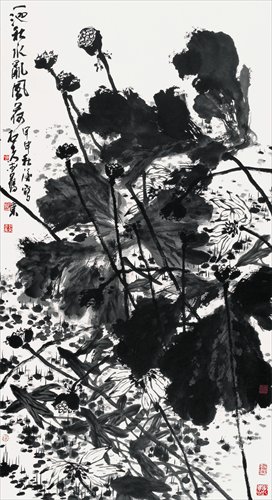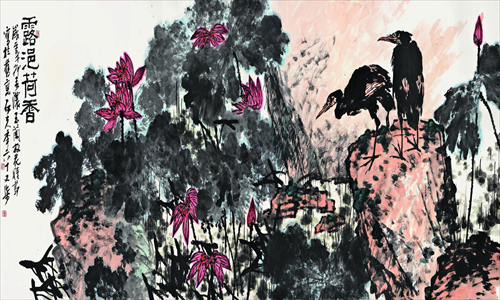Famous painter of Chinese traditional paintings describes his life and art

Celebrated Chinese painter Guo Shifu paints in his studio in Beijing. Photo: Courtesy of Guo Shifu
Traditional Chinese bird-and-flower painting has a number of schools, and among them is the "free-sketching" school, which uses simple line drawings to represent more complicated images and artistic concepts. Over the past 100-plus years, free-sketch bird-and-flower painting has seen growing popularity in China among both artists and the public, and today a number of well-known modern painters like Wu Changshuo and Qi Baishi have gained mastery of (and helped promote) this genre.
Among the most celebrated artists of this school is Guo Shifu, an outstanding contemporary painter in his 60s. Despite his advanced age, Guo remains a tower of strength in China's traditional ink painting circles and his work is still improving.
While Guo shares a number of similarities with his creative peers, what makes him a truly great artist are his unique life experiences.

Guo Shifu engraves a seal at his Beijing-based studio. Photo: Courtesy of Guo Shifu
The early years
Guo was born in Beijing to a family of artists in 1945. Although Guo says he was a relatively naughty child, he had great enthusiasm for art due to the atmosphere at home. His father was in the army, but, like other members of their family, was very skilled at Peking Opera. Guo's grandmother, meanwhile, was a calligrapher and Chinese traditional ink painter. These family influences helped inspire his early interest in art.
Guo began studying Peking Opera, calligraphy and painting at a young age and started to make a living selling his paintings as early as 13.
Guo is a self-taught painter but counts Rongbaozhai (a time-honored art gallery and shop in Beijing, with a history of more than 300 years in dealing with precious antiques and art works) and the Palace Museum as his "teachers." Over the years, whenever he visited either the shop or the Palace Museum, he would carefully study the paintings and try to observe the artists' technique to learn from them.
Both Peking Opera and Chinese traditional ink painting are regarded as containing the quintessence of Chinese culture, and have a lot in common in terms of aesthetics. Having been greatly influenced by the two art forms since childhood, it's no wonder Guo has grown into such an outstanding artist.

Yi Chi Qiu Shui Luan Feng He (180 cm x 96 cm, 2004) Photo: Courtesy of Guo Shifu
Love for stones and flowers
Guo's parents named him Guo Lianzhong but his love for stones led him to have it legally changed to Shifu ("stone man"). He also coined the alias Wanshizi ("a hard stone"), which he uses as his personal stamp on many of his works.
The name change stemmed from his experiences during the Cultural Revolution (1966-76), at which time he worked at a machinery factory where he was often criticized and humiliated because of his love for art. The experience taught him a hard lesson: People must be like stones in order to survive the chaos of society. So he changed his name to Shifu as a constant reminder that one should be resilient in the face of hardship.
In 1984, he was appointed to the Beijing Fine Art Academy, which was the first time he got the chance to study art in a systematic and structured way. His skills improved rapidly, and he soon discovered a passion for free sketching.
Later that year, Guo married a woman named Zhang Shufang. In Chinese, the character fang means flowers, so he named his home Youfangshi ("a house with flowers"). The name is quite fitting from an artistic perspective, as flowers have often been the subject of his masterpieces.
According to Guo, artists must observe the things they draw carefully, and should be able to make a spiritual connection with nature in order to get inspiration. "Free-sketch flower-and-bird paintings represent an emotional harmony between artists and mother nature," said Guo.

Mo Lan (180 cm x 48 cm, 2014) Photo: Courtesy of Guo Shifu
The power of art
Guo strives to make his paintings powerful and impressive. The secret to obtaining this feat lies in how he observes nature and depicts it in his art. His strokes are hard, powerful and sometimes even aggressive. He loves to paint plum blossoms, orchids, bamboo and chrysanthemums, all of which are thought of in traditional Chinese culture as tough and strong plants.
As for birds, he prefers eagles, pigeons and mynas, which are all relatively strong birds.
He also paints landscapes. He likes strong symbols and images, and his style and method of painting are greatly influenced by both ancient and modern artists, but with his own unique characteristics.
Yet it isn't sharpness, but rather the simple and earthy elements of his paintings that make them impressive.
Perhaps it has something to do with Guo's character. He is a simple, tough guy who grew up in North China, and his style is just as simple and tough.
He is also careful and smart, and pays close attention to details. For example, he carefully plans out the color scheme of every painting, and the shape of every plant is so rendered as to create a feeling of harmony in his paintings.

Lu Yi He Xiang (145 cm x 368 cm, 2011) Photo: Courtesy of Guo Shifu
The secret of free-sketch art
According to Guo, at the essence of the free-sketch school is the desire for the artists to fully express their emotions through art. Since many free-sketch artists prioritize the emotion of their work over technique and details, some people regard the genre as being simple and abstract.
Nowadays, many free-sketch artists lack emotion in their work, but Guo is different. According to him, emotions, drawing skill and the layout of a painting are all integrated.
Over the years, Guo has also written and read many poems, practiced calligraphy and reflected on his painting skills. As part of that process, he has worked to incorporate a number of new painting techniques into traditional Chinese painting by integrating Western abstract expressionism.
As for artistic innovation, he has his own opinion. "Although it is a trend to try and bring new innovations to artistic creation, we have to follow certain rules and objective laws of art," said Guo. "Almost all famous painters have forged their own creative innovations through tireless practice and creating facsimiles of classic works, so it is impossible and ridiculous for a young artist to establish his or her own school at the start of his or her art career."
For his part, Guo has followed the traditional method of gradual learning from his predecessors, and eventually found his own style. In autumn of last year, he created many new paintings. With their original simplicity and depictions of nature, the works appear graceful and gentle. Through his persistent practice, he gradually came to realize that the most difficult part of making art is maintaining the tradition of a specific style's original characteristics while attempting to innovate.
Guo is too fascinated with traditional art to stop learning and creating new work. Although it is difficult, he remains dedicated to improving himself and China's free-sketch school by extension.
Introduction to the artist:
Guo Shifu was born in Beijing in 1945. He is famous for his free-sketch style of traditional Chinese ink paintings.
Guo is a member of the China Artists Association, a member of the Beijing Fine Art Academy's Art Committee and an artist of the highest level nationally.
A talented artist, Guo also excels at calligraphy, engraving, Peking Opera and Western-style painting and poetry.
Newspaper headline: Guo Shifu, a master of free-sketch